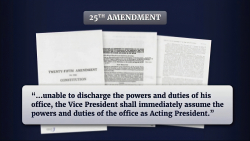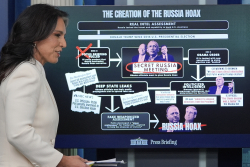The artificial intelligence boom needs power, but nuclear energy in the United States lacks the policy and funding to deliver at speed.
The hope that new nuclear energy can be quickly synced with rapidly expanding artificial intelligence (AI) data centers is currently running out of phase with reality.
The data center explosion is the most recent driver of the “nuclear power renaissance,” and there is a convincing case for its value to these power-hungry plants. Reactors can provide steady energy for decades.
But there are substantial headwinds to success posed by reactor uncertainty, deployment costs, supply chain gaps, an inadequate workforce, and regulatory hurdles. Then there’s the ever-looming competition from Russia and China and their government-centric offerings.
Overcoming these challenges requires a strategic package of public-led and private sector implemented financial, regulatory, and policy responses. This is something that the United States and its allies have not been capable of developing so far.
Artificial Intelligence Eruption
The Trump nuclear executive orders (EOs) are designed to accelerate the nuclear deployment timeline to match new technologies with market demand. But that extensive set of policy initiatives is not enough to catch an artificial intelligence wave that is rapidly building into a tsunami.
At the beginning of 2024, there were over 10,000 data centers worldwide, with over half in the United States (5,388). Eight of the other top ten nations were US allies. The exception was Russia.
A Deloitte Research Center analysis predicts that US data center power requirements could rise to 176 gigawatts (GW) by 2035, up from 33 GW in 2024.
To meet the expected demand, Amazon is building an AI datacenter on 1,200 acres of former farmland in Indiana that will become the largest power consumer in the state. Two-thirds of the 2.2 GW of electricity needed to operate this behemoth will be provided by natural gas.
Similarly, OpenAI is building the Stargate I data center site in Abilene, Texas, which initially will rely on a combinationof natural gas and renewables for its power.
Meta has announced a four-million-square-foot, $10 billion data center for construction in Monroe, Louisiana, and Amazon Web Services is matching that $10 billion with a new data center in Ohio.
It is conceivable that once new nuclear power deployment has accelerated, it could replace natural gas as the primary data center power source, but it will have to be cost-competitive or the transition incentivized by the US government.
Relicensing, Restarting, and Uprating Reactors
Existing large reactors can provide some nuclear juice for data center expansion in the short term, especially through the relicensing and uprating of operating plants and the resurrection of mothballed reactors.
For example, Three Mile Island Unit 1 is scheduled to be reopened in 2028 as the Crane Clean Energy Center as part of a deal between Constellation Energy and Microsoft.
The Palisades nuclear plant in Michigan will also reopen with support from a loan guarantee from the US government.
Meanwhile, NextEra Energy is seeking to restart the Duane Arnold Energy Center in Iowa.
The Trump EOs aim for five GW of growth from existing reactors through uprating the power output, and the Nuclear Regulatory Commission (NRC) is anticipating 30 power uprate applications through 2030.
Searching for Incentives
The surge in nuclear output from existing and restarted reactors will be a welcome boost, but there are currently no new reactors under construction in the United States.
Westinghouse has announced that it intends to build ten new reactors in the United States. That is in line with the president’s EOs. But with a start date of 2030, which is five years from now, and a 10-year construction time, they may be too late for this wave of the AI boom.
Also, the target of much of the US government and tech companies’ funding is smaller next-generation nuclear reactors that promise lower cost and greater flexibility.
But many next-gen reactors reside on a drawing board, are wading through the licensing process, and are at least a decade from deployment. That creates a data center deployment disconnect that could crater American nuclear competitiveness.
Spurred by the Trump EOs, the Department of Energy (DOE) has announced four federal reservations on which energy infrastructure to support AI data centers can be deployed.
Two of them, Idaho National Laboratory and Oak Ridge Reservation, already are major test beds for next-generation nuclear reactors.
The others, the Paducah Gaseous Diffusion Plant and Savannah River Site, are historically connected to uranium enrichment and spent fuel reprocessing, respectively. Further details regarding each site will be released by DOE in the future.
Also, the administration is pushing ahead with Department of Defense small reactors, which are government-funded. The EOs further call for three pilot reactors to be built and tested outside the national laboratories with the goal of going critical in July 2026. This could spark the process.
Creating a Strategy and Package
While the scope of the Trump nuclear policy directives is very substantial, their sheer density makes it difficult to discern if there is a strategy in them designed to shake the foundations of nuclear business as usual.
If the plan primarily rests on hollowing out the Nuclear Regulatory Commission and relying on private sector financing, it will not be a winning strategy for accelerating deployment.
The president’s EOs called for the development of a nuclear export strategy, but they didn’t mandate a strategy for restructuring nuclear power expansion at home.
At the very least, a major item missing for both domestic and export deployment is the role of expanded government financing or loan guarantees. The Trump budget request has preserved the existing nuclear loan program but cut the funding for nuclear energy research and development, and offers no new financial incentives.
The private sector will not be able to carry the burden of nuclear development and deployment without a government partner. That is the package that has been used very successfully by Russia and China. Sovereign guarantees were essential for the development of nuclear power in the United Arab Emirates.
The administration has done a commendable job of identifying its nuclear objectives and the component elements that are required to meet them. What it hasn’t done is create the strategy and financial incentives package that will allow it to successfully meet the artificial intelligence opportunity.
Time is running out, and continued delay could drive the renaissance to ruin.
About the Author: Kenneth Luongo
Kenneth Luongo is the president and founder of the Partnership for Global Security (PGS) and the Center for a Secure Nuclear Future.
Image: Rawpixel.com/Shutterstock


















